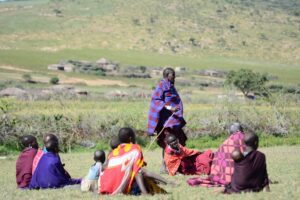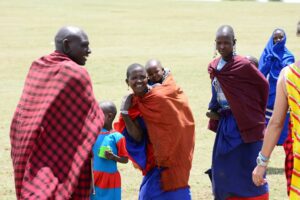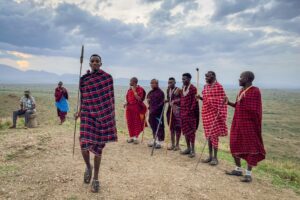Indigenous land of the Maasai is seized in the name of profit and ‘conservation’
The Maasai people, who rely on pastoralism of wild rangelands for their livelihoods, have been denouncing the ongoing harassment and eviction from their traditional territories. After having been resettled in the 1950s to make place for the Serengeti National Park, up to 150,000 Maasai have been displaced for the further expansion of the conservation and hunting area bordering Serengeti National Park. This is despite the fact that Tanzania’s Multiple Land Use Model recognizes their right to live in the area and tend to the herds of cattle, sheep and goats that guarantee their survival. Despite the governments’ claim that the resettlement is necessary to protect the area’s fragile ecosystem, the real motivations are economic given that tourism in the area is supposed to grow. In reality, the Maasai play a fundamental role in preserving and sustainably managing their territory, which is one of the best conserved grasslands in the world. The refusal of the Maasai to leave their villages has been met with disproportionate violence by security forces, causing injuries, arrests, food insecurity and the disintegration of social support systems. The Tenure Guidelines and the new Global Biodiversity Framework reaffirm the rights of Indigenous Peoples over their ancestral lands and territories as well as their free, prior and informed consent to any project or policy that may affect their rights.
On June 10, 2022, several members of the Maasai and village elders from the Ololosokwani village, situated in the Ngorongoro district on the eastern edge of the Serengeti National Park, met to peacefully protest the demarcation of their land by the Tanzanian Government. Minutes later, members of the Tanzanian military arrived and fired tear gas and rubber bullets. Video footage shows people running from authorities, including children and elderly people. More than thirty persons were injured during the military intervention. One week later, 27 members of the Maasai, including ten community leaders, were arrested, charged with the death of a police officer during the skirmish. After being detained for months without recourse or representation, the prosecutors dropped the criminal charges in November 2022 and released them. Hundreds fled during and after the violent clash in June. Some sought refuge in neighboring villages, while others crossed into Kenya, including to seek medical treatment for serious injuries.
This is just one in a series of attacks against the Maasai people in their native lands, perpetrated by authorities claiming they are concerned with protecting critical ecosystems. The Maasai people are one of the most well-known ethnic groups in Africa, known for their distinctive culture, traditions and way of life. The semi-nomadic and pastoral people, which consists of about 1 million persons, has lived in East Africa for centuries, and their culture is deeply rooted in their land. While many other Indigenous Peoples in East Africa have lost many of their traditional practices, the Maasai’s historical culture and customs persevere. In recent years however, the Maasai people have faced increasing threats to their rights and way of life, including the displacement from their traditional lands in Tanzania.

© Maasai Speakers’ Tour
The colonial legacy of ‘fortress conservation’ on Maasai territories
The most recent displacement effort is targeting the Loliondo division of the Maasai people, a subgroup of around 70,000 people that has lived in northern Tanzania’s Ngorongoro district for generations. The Loliondo pastoralists are members of the World Alliance of Mobile Indigenous Peoples (WAMIP). In 1951, 400,000 hectares of Loliondo division in Ngorongoro district were reserved for tourism and hunting wildlife, yet the Maasai maintained their right to live in the area and tend to the herds of cattle, sheep and goats that guarantee their survival. However, in recent years, the Tanzanian government has declared its intent to transform 150,000 hectares into a protected area under the management of the Tanzanian Wildlife Authority (TAWA).
In 2021, the government issued an eviction notice to the Loliondo Maasai, ordering them to surrender their land to a hunting reserve. Despite widespread outrage and resistance from the Maasai as well as activists and human rights groups, the government continued to pursue the eviction. In June 2022, authorities demarcated 14 village areas to be transformed into a game reserve. This was the trigger of the violence and arrests described above, and has been the starting point of a new wave of harassment against the Maasai in the area.
The displacement of the Maasai from their territories goes back many decades. In the 1950s, they were resettled from the area that is now the Serengeti National Park to the Ngorongo Conservation Area (NCA), which was designated as a Multiple Land Use Area, i.e. an area where the Maasai were allowed to live along with conservation activities and tourism. Now, the Tanzanian government plans to expand the size of the NCA from 8,100 to more than 12,000 sq km (including parts of Loliondo) and divide the entire area into four management zones with varying land use rules governing the areas. The proposed zones include a conservation core zone, conservation sub-zone, transition zone, and a settlement and development zone. This reduces significantly the land available to the Maasai for pastoralism, settlements, and farming crucial to their lives and livelihoods. Indeed, the government’s plan restricts nearly all human settlement and development to 2,230 sq km, just 18 percent of the total area.
In 2021, the Tanzanian government elaborated a resettlement plan, which foresees the relocation of 82.000 Maasai until 2027. This is justified with the need to protect the local ecosystems from the supposedly unsustainable use of a rising number of inhabitants. The government claims that it has offered financial support to those households who accept to be relocated, an offer some households allegedly accepted. But the government has not left it at that. To increase the pressure, it keeps coming up with new repressions against the population: since 2022, the subsidy for the schools has been cut, so that although the buildings still exist, they are empty. The children must sit on the floor when classes are held. The school bus no longer functions so that children are forced to walk long distances. Water pipes are being cut back so that the women, who are traditionally responsible for fetching water, have to walk long and dangerous distances to provide for their families. Moreover, the local hospital has virtually closed and only two persons remain to maintain care for a population of almost 100,000. The Flying Medical Service, which helped people in remote areas for 39 years, has not been allowed to fly since April 2022. The supply situation is dramatic, especially for pregnant women, elderly people, single female-headed households and children, and the government’s violent actions in June 2022 have further disrupted social support systems and weakened local safety nets. As a result, the Maasai are now heavily affected by food insecurity, malnutrition and dependence on inadequate food, threatening their very survival. Together with the effects of climate change, the impacts on Indigenous communities are devastating.
Although the government claims to act in the name of ecosystem protection, the real motive is most probably rather economic. While proposing to evict the Maasai, the Tanzanian government plans allowing tourism and trophy hunting in the NCA. Indeed, tourism in the area, which contributes more than 10 percent of country’s gross domestic product (GDP), has increased massively from 20,000 annual tourists in 1979 to 644,155 in 2017/2018. In parallel, revenues from tourism activities in Tanzania generated over US$2.6 billion.
Maasai leaders and lawyers have challenged the legality of the eviction in court. Additionally, UN human rights experts, the African Commission on Human and People’s Rights, the United Nations Permanent Forum on Indigenous Issues and several civil society organizations have issued statements condemning the eviction and calling on the Tanzanian government to respect the rights of the Maasai. Within the group itself, residents of Loliondo have been organizing and mobilizing to resist the eviction through protests and public meetings demanding direct action to denounce these abuses. Moreover, WAMIP is preparing an official communication to the Tanzanian government to demand the respect of the Loliondo pastoralists’ rights and implementation of Tanzania’s human rights obligations. However, some key partners of the Tanzanian government’s conservation program, such as the government of Germany and the Frankfurt Zoological Society have remained silence in the face of the human rights violations against the Maasai in the Ngorongoro district.
The displacement of the Maasai from their territories goes back many decades. The most recent displacement effort is targeting the Loliondo division, a Maasai subgroup of around 70,000 people.

© Maasai Speakers’ Tour
